On Christmas Day of 2004, Wes Anderson released The Life Aquatic With Steve Zissou. It was his fourth full-length motion picture, and to this day it’s also his biggest box-office flop. It failed to recoup even half of its budget domestically, and while the reviews weren’t exactly scathing, it was rare to read one that didn’t express immense disappointment. It’s also my favorite film of all time.
I do remember, however, being slightly disappointed by it the first time I watched it, which was a few days after its release in theaters. It was good, but it didn’t feel as dense or substantial as Anderson’s previous films. It was funny, but basically shallow.
Then, not long afterward, I saw it a second time because another friend of mine asked me to go. And that’s when it clicked. It became — suddenly — profound, effective, and brilliantly moving. The first time I watched it I was looking for an experience along the lines of the rich, many-leveled The Royal Tenenbaums, and was disappointed that I encountered something else entirely. The second time I approached the film for what it was, and I haven’t looked back since.
Like the film of Steve’s that opens this movie, the release of The Life Aquatic was met with an almost audible shrug from the masses. But many of those who dislike it, it’s safe to say, never did give it a second chance, and never did engage the movie on its own terms, rather than theirs. And that, I have to say, is their loss.
It still stands, in my humble opinion, as Anderson’s crowning achievement. So congratulations, Wes. Seriously.
We open the film with two immediate announcements that we are in Wes Anderson’s world. One of which is visual, and the other aural. Visually, it’s his signature Futura font, uniquely displayed in this film as being symbolically hollow. The font is Anderson’s stamp of approval, to be sure, but its emptiness here stands as a thematic reflection of the film’s main character. He may present himself externally just as he always has, but something has changed. The heart isn’t there. He’s the Zissou, but there’s nothing inside. The hollow font suggests the surface…and also a vast, empty realm below. That’s one of the film’s great themes, and we start exploring it with literally the first frame.
Aurally, we have Mark Mothersbaugh’s score, which, at this point in Anderson’s career, was another signature component of his films. We’ll talk more about the music in a later installment — and about this piece in particular in the next — but I would like to say that as strong as the soundtrack is, it does come across as a bit indecisive, and attempting to do too many things at once. You have Mothersbaugh’s orchestral material, and you also have a complete sub-soundtrack of the same songs performed with deliberate Casio-like cheesiness. On top of that you have Sven Libaek’s Inner Space score reappropriated here as the score of Steve’s own films, the requisite helping of deep-cut pop songs from Anderson’s past, and Seu Jorge performing solo acoustic David Bowie tunes in Portuguese. If that’s not a tonal car-wreck I don’t know what is, and it’s telling that his next film, The Darjeeling Limited, took a deliberately single-minded approach to its soundtrack, almost as if in response to the aimlessness of this one.
After a brief introduction by Antonio Monda — playing himself — we see Steve’s latest film, which is debuting here at the Loquasto International Film Festival. We’ll hear more from Monda in a bit, but for now he presents the audience — both inside and outside of the film — with an itinerary: we will watch the movie, and then there will be a Q&A. Both of those promises, in sequence, are indeed fulfilled, and we have our first example of the film-long obsession with structure. Team Zissou’s days are meticulously planned and deviation is not welcomed. Steve’s even determined that this film is “Part One,” long before he’s started planning the sequel. At the end of the day, everything is neatly packaged into embellished documentaries with predictable flows. Steve’s world is one of total, necessary order. For now.
His film, as well as the one we’re watching, is called The Life Aquatic. We see the titles, and so does the audience within the film. There’s something interesting about these titles that is undoubtedly worth mentioning, but there’s a better place in the film to discuss them, so I’ll save that for a future installment. For now, however, it’s worth pointing out that these function as both our credits and theirs. The “With Steve Zissou” caption completes our film’s title here in the real world, while within the reality of this movie it is simply giving special attention to its star. It works on two levels of reality, simultaneously, in two different ways.
We also see — and likely chuckle at — the low production values of Steve’s film. The jump cuts are obtrusive, the film grade is low, the white balancing is off, and his team of film-makers / oceanographers struggle to conceal themselves out of view while the cameras are rolling.
Steve lists off the current members of Team Zissou, and we’ll talk about their lack of qualifications in the next installment, and probably many others as well. In the meantime, let’s defer questions of characterization and focus instead on what we see here visually.
One of Anderson’s hallmarks is his haziness in terms of when a particular film takes place. They seem as though they could exist in many possible eras at once (with the exception of his most recent, Moonrise Kingdom, which is actually given a specific date in history…and yet is still presented as a fairy tale or fable).
The quality of Steve’s film openly suggests the kinds of outdated documentaries a student might see in science class on a day that the teacher is sick, and as such that puts its production values in line with, say, the mid-1970s output we know here in the real world. That — along with Steve’s similarly outdated and failing equipment aboard the Belafonte and at his compound on Pescespada Island — does seem to suggest a possible time period for the film. It’s not, however, until we see the sleek, modern equipment of Operation Hennessey that the joke really clicks: Steve is not only a relic in time, but a relic in his own as well. We never do get to see one of Hennessey’s movies, but it’s safe to assume that his film would be a more professional, tightly-packaged and educational one that what we see here.
Steve is a living fossil…a man in denial of who he is, moving through life as though he’s still what he once was. He achieved celebrity from his films, and never thought to evolve them over time. He clings to past triumphs, but never realizes that he might have sold out his relevancy long, long ago. Tellingly, Team Zissou HQ is littered with artifacts of long-dead endorsement deals, such as branded pinball machines, action figures and, of course, the shoes. These mementos function both as reminders of the fame Steve once commanded so easily, and how desperate he is to cling to his past.
This is the real journey for Captain Zissou. He must, now, in his declining years, learn to accept who he actually is…and stop clinging to the exception that he once — and likely briefly — was. But for now, Steve’s content to go through the motions, to film sealife as though he’s the only one who’s ever done it or ever would think to do so. His narration is uninformative and devoid of either emotion or interest in what he’s doing. He’s going through the motions, and that carelessness of approach may very well be what got his partner Esteban killed.
We see Steve and Esteban in this sequence, staging emotional moments just as Steve will attempt to do later with Ned, for the sake of his “relationship sub-plot.” We also see the sealife itself, appearing almost deliberately fake…on Anderson’s part. The suggestion is raised within the film that his footage might also seem fake in Steve’s world, and there will be plenty of opportunity to discuss that later as well, as at least one character is savvy enough to call him on it.
The potential falseness of the Fluorescent Snapper gives way to the central tragedy of Steve’s film: Esteban’s death by the never-seen Jaguar Shark.
Steve’s quest for exacting revenge upon the Jaguar Shark is set up here — clearly and forcefully — as the driving force behind The Life Aquatic With Steve Zissou. And yet, just a few scenes from now, Steve will find himself permanently derailed by an unforeseen intrusion into his carefully constructed — and isolated — existence…that of his possible son Ned.
This sort of derailment is common in Anderson’s films; we’re pointed in one direction, and then suddenly the characters are forced by fate to advance in another. Dignan’s team of bandits falls apart, Max is expelled from The Rushmore Academy, Royal is kicked out of the house, the Whitmans are tossed off the train, and Sam and Suzy’s campsite is discovered. (Something probably happens to Mr. Fox too but I don’t give a shit.) Here the main narrative drive is interrupted by a pirate attack later in the film, but Steve’s emotional drive is interrupted much sooner, by a polite young man in a pilot’s uniform who wanted to meet him, just in case.
In fact, Ned’s arrival is such an interruption that Steve needs to be reminded several times that Esteban ever existed. First — and disastrously — by Steve’s wife Eleanor, and again when Ned stitches a tribute to the dead man into the new Team Zissou insignia. It’s tempting to believe that Steve forgot Esteban, but he didn’t; he merely pushed it under the surface because he wasn’t prepared to deal with it maturely. Instead of preparing, he barrels forward toward vague revenge, this time with Ned in Esteban’s place. And we all know how that turns out.
Esteban’s death is not shown, but we do see Steve panicking in a blood-red sea. Once again we get a sense of the importance of “packaging” to Steve, as he fearfully questions his crew as to whether or not the cameras are rolling, even while he shouts that his closest friend has been bitten in half.
This is a comic moment, or at least appears to be, as Steve sounds equally concerned about the quality of his film as he is about what just happened to his friend, but it actually speaks to a genuine — and severe — character flaw in Steve. We’ll see it more later on with Ned, and — as we cannot do with Esteban — we will be able to chart the logical progression of this mindset all the way through to its necessarily tragic end.
There’s an additional level of comedy on display here, due to Steve’s heavy-handed editing techniques. He itemizes anything important on screen in the form of captions, culminating in the criminally unnecessary all-caps proclamation “ESTEBAN WAS EATEN.”
Klaus’s confusion is his first chance to shine as a character, and his inappropriately adorable bafflement here will have a fantastic payoff in the mutiny scene to come.
For now, though, Esteban’s death weighs heavier on Steve than it does — or can — anywhere else in the movie. This is Steve at his most brittle, and he still has a Q&A session to attend to before he can retreat to the (ironic, given what we’ve just seen) safety of the sea.
When Steve’s film ends, we see that about one third of the previously packed screening hall is deserted. We also see, in a brilliant bit of visual blocking, Steve in two modes at once: calm and composed above the surface of the table, restless and fidgety beneath. He’s right on the edge. He doesn’t know what comes next.
The Q&A session is brief, as promised, but it reveals and establishes quite a few things before it ends.
Most obviously, this is our introduction to Ned, though we would be forgiven for not realizing that the first time through. (On a personal note, on my second viewing of this film, I remember feeling my heart break when he asks his unknowingly loaded question, “What’s next for Team Zissou?”) It’s this image, of this man, this man Steve has never met, standing on a balcony and asking exactly the kind of softball question Steve likes to answer most, that will flash before his eyes in the moment of near-death. In a life as hollow as Steve’s, this qualifies as a highlight.
We also learn about Steve’s lack of fondness for the sealife he documents. He’s perfectly content to murder a living creature for the purposes of revenge, even though the creature would not have any idea of what it did wrong, and he’s content to do it with the massively destructive force of dynamite to boot. It’s emblematic of Steve’s self-centered view of the world around him, and we’ll see that play out in one particularly horrific way after the pirate attack.
But most interesting is Steve’s matter-of-fact answer to a very fair question. Someone in the audience asks him if it was a deliberate choice not to show the Jaguar Shark, and Steve answers that he dropped the camera.
What’s interesting about this is that later in the film, during a verbal confrontation with a reporter, he uses this precise scene — this scene that we’re being told was never filmed, let alone broadcast — to illustrate the realness of what he’s doing. He asks her if it looked fake when Esteban was bitten in half before his eyes…but, here, we see that she couldn’t possibly answer that question, as nobody apart from Steve could have seen it. In one case he’s apologizing for not showing it, and in another he’s berating a reporter for not understanding it.
It’s one of several times that Steve provided conflicting accounts of his own experiences. Another, and perhaps a more important one, has to do with whether or not he knew about Ned.
But Steve’s hypocrisy isn’t coming into play just yet, so if there are no further questions, there will be a brief meet-and-greet in the atrium.
Next: The Long, Dark Wine and Cheese Party of the Soul
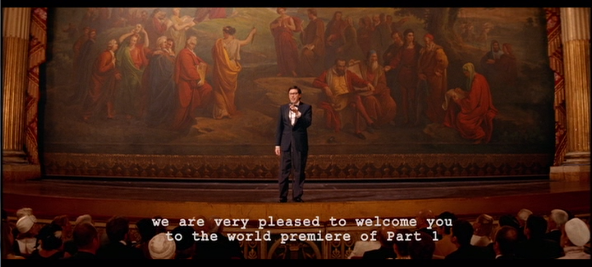
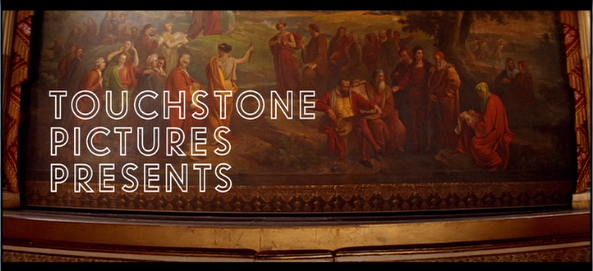
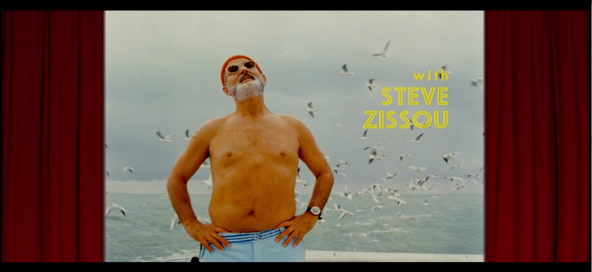
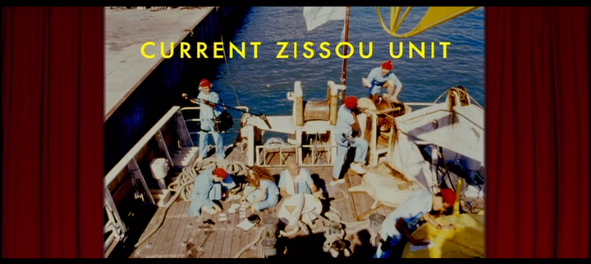
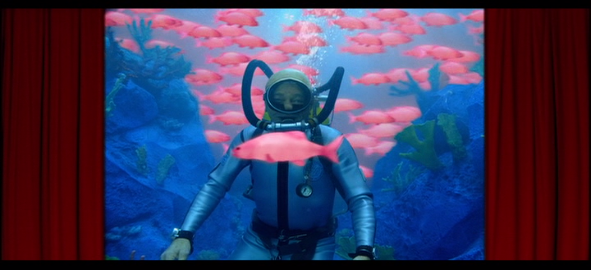
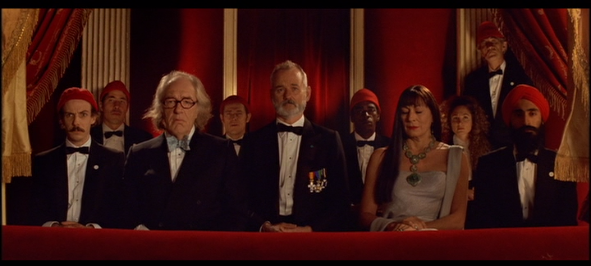

Just re-watched last night, love this movie! Do you think there’s any significance to the large painting in the theater? I don’t, but still am trying to recall the name and artist. I’m sure I came across it otherwise once, and even researched what it depicted (which I remember being a bit of a let-down).
Do you happen to know?